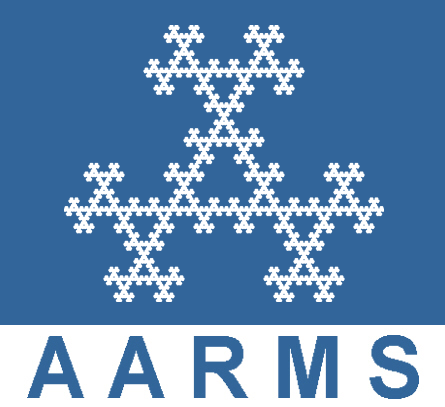2017 CMS Winter Meeting
Waterloo, December 8 - 11, 2017
- JULIA BRANDES, University of Waterloo
Vinogradov systems missing the linear slice [PDF]
-
The resolution of Vinogradov's Mean Value Conjecture by Wooley and Bourgain, Demeter and Guth (see previous talk) has transformed our understanding of systems of diagonal equations. We are now able to obtain sharp mean value estimates for systems of Vinogradov type, consisting of one equation of degree $j$ for al $1 \le j \le k$, in which it is possible to take advantage of certain symmetries of the system. In this talk we will explore systems of Vinogradov type, where the linear equation has been removed. It turns out that by elementary means it is possible to establish diagonal behavior in a larger range than what follows from Efficient Congruencing and $\ell^2$-decoupling methods. This is joint work with Trevor Wooley.
- KARL DILCHER, Dalhousie University
Derivatives and special values of higher-order Tornheim zeta functions [PDF]
-
We study analytic properties of the Tornheim zeta function $T(r,s,t)$, and in
particular the case $\omega_3(s):=T(s,s,s)$. While the values at positive integers have long been known, we evaluate $\omega_3(0)$ and show that $\omega_3(m)=0$ for all negative integers $m$. As our main result, we find the derivative of this function at $s=0$, which turns out to be surprisingly simple. I will also show that all these results have analogues for Tornheim zeta functions of arbitrary orders. These results were first conjectured by J. Borwein and D. Bailey using high-precision calculations based on an identity due to R. Crandall that involves a free parameter and provides an analytic continuation. This identity was also the main tool in the eventual proofs of our results.
(Joint work with Hayley Tomkins).
- DANIEL FIORILLI, University of Ottawa
Low-lying zeros of quadratic Dirichlet $L$-functions: the transition [PDF]
-
I will discuss recent joint work with James Parks and Anders Södergren. Looking at the one-level density of low-lying zeros of quadratic Dirichlet $L$-functions, Katz and Sarnak predicted a sharp transition in the main terms when the support of the Fourier transform of the implied test functions reaches the point $1$. By estimating this quantity up to a power-saving error term, we show that such a transition is also present in lower-order terms. In particular this answers a question of Rudnick coming from the function field analogue. We also show that this transition is also present in the Ratios Conjecture's prediction.
- TRISTAN FREIBERG, University of Waterloo
Variance for primes in arithmetic progression: sparse, sparser,... [PDF]
-
Using Goldston's and Vaughan's approach to the Montgomery-Hooley
asymptotic formula, Brüdern and Wooley extended this asymptotic
to the case where the moduli run over polynomial values. As
suggested by Brüdern and Wooley, the method of proof allows one
to look at even sparser variance: we consider moduli of the form
$\big[\exp\big((\log k)^{\gamma}\big)\big]$, where
$1 < \gamma < 3/2$. This is joint work with Roger Baker.
- JOHN FRIEDLANDER, University of Toronto
Twin primes via exceptional characters [PDF]
-
We sketch our arguments (joint with H. Iwaniec) which lead from the assumption of the existence of exceptional Dirichlet characters to the asymptotic formula in related ranges for the distribution of twin primes, providing our own version of a well-known theorem of R. Heath-Brown.
- ALIA HAMIEH, University of Northern British Columbia
Special Values of L-functions of Hilbert Modular Forms [PDF]
-
This talk is based on joint work with Naomi Tanabe. We discuss the family of central values of the Rankin-Selberg convolutions of two adelic Hilbert modular forms both of which have varying weight parameter k. We prove that a large number of these values (though still of zero density) are non-vanishing. We also present an asymptotic formula for a (mollified) first moment of these values.
- MATILDE LALIN, Université de Montréal
Remarks on the Mahler measure for arbitrary tori [PDF]
-
The Mahler measure of a Laurent polynomial $P$ is defined as the integral of $\log|P|$ over the unit torus with respect to the Haar measure. For multivariate polynomials, it often yields special values of $L$-functions. We consider a variation of the Mahler measure where the defining integral is performed over a more general torus. We focus our investigation on two particular polynomials related to certain elliptic curve $E$ and we establish new formulas for this variation of the Mahler measure in terms of $L'(E,0)$. This is joint work with my summer student T. Mittal.
- YOUNESS LAMZOURI, York University
Prime number races with many contestants [PDF]
-
We investigate the logarithmic densities in prime number races with $r$ competitors modulo q, when $r, q\to \infty$, assuming the standard conjectures GRH and LI. Among our results, we uncover an interesting transition in the asymptotic behavior of these densities when $r=(\log q)^{1+o(1)}$. First, in a joint work with A. Harper, we prove that these densities are all asymptotic to $1/r!$ when $r\leq (\log q)^{1-\epsilon}$, thus showing that all biases dissolve in this range. On the other hand, in a recent joint work with K. Ford and A. Harper, we show that when $r/\log q\to \infty$, there exist r-way prime number races where the densities are much smaller than $1/r!$, and others where the densities are much larger than $1/r!$, answering a question of A. Feuerverger and G. Martin. The proofs use various probabilistic tools, including a version of Stein’s method of exchangeable pairs, and a quantitative multidimensional Gaussian approximation theorem, obtained through Lindeberg’s method.
- ALLYSA LUMLEY, York University
Distribution of Values of $L$-functions associated to Hyperelliptic Curves over Function Fields [PDF]
-
In 1992, Hoffstein and Rosen proved a function field analogue to Gau\ss' conjecture regarding the class number, $h_D$, of a discriminant $D$ by averaging over all polynomials with a fixed degree. In this case $h_D=|\text{Pic}(\mathcal{O}_D)|$, where $\text{Pic}(\mathcal{O}_D)$ is the Picard group of $\mathcal{O}_D$.
Andrade later considered the average value of $h_D$, where $D$ is monic, squarefree and its degree varies. He achieved these results by calculating the first moment of $L(1,\chi_D)$ in combination with Artin's formula relating $L(1,\chi_D)$ and $h_D$. For this talk we discuss the complex moments of $L(1,\chi_D)$. We show that these moments are very nearly equal to those of a random probabilistic model. We also describe the distribution of values for both $L(1,\chi_D)$ and $h_D$.
- GREG MARTIN, University of British Columbia
The distribution of the number of subgroups of the multiplicative group [PDF]
-
Let $I(n)$ denote the number of isomorphism classes of subgroups of $(\mathbb{Z}/n\mathbb{Z})^\times$, and let $G(n)$ denote the number of subgroups of $(\mathbb{Z}/n\mathbb{Z})^\times$ counted as sets (not up to isomorphism). We prove that both $\log G(n)$ and $\log I(n)$ satisfy Erdös–Kac laws, in that suitable normalizations of them are normally distributed in the limit. Of note is that $\log G(n)$ is not an additive function but is closely related to the sum of squares of additive functions. We also establish the orders of magnitude of the maximal orders of $\log G(n)$ and $\log I(n)$.
- RAM MURTY, Queen's University
Hilbert's tenth problem over number fields [PDF]
-
Hilbert's tenth problem for rings of integers of number fields remains open in general, although a conditional negative solution was obtained by Mazur and Rubin assuming some unproved conjectures about the Shafarevich-Tate groups of elliptic curves. In this talk, we highlight how the non-vanishing of certain L-functions is related to this problem. In particular, we show that Hilbert's tenth problem for rings of integers of number fields is unsolvable assuming the automorphy of L-functions attached to elliptic curves and the rank part of the Birch and Swinnerton-Dyer conjecture. This is joint work with Hector Pasten.
- JONATHAN SORENSON, Butler University
Open problems related to finding strong pseudoprimes [PDF]
-
In joint work with Jonathan Webster, we presented an algorithm that, given $x,m>0$, finds all integers $\le x$ that are strong pseudoprimes to the first $m$ prime bases. Under the assumption of some conjectures, and assuming $m\rightarrow\infty$ with $x$, this algorithm takes at most $x^{2/3+\epsilon}$ time, for $\epsilon>0$. (doi.org/10.1090/mcom/3134)
After a quick overview of how the algorithm works, in this talk we will discuss several conjectures/open problems in analytic number theory that arise in the running time analysis of this algorithm.
- AKSHAA VATWANI, University of Waterloo
Zeros of partial sums of $L$-functions [PDF]
-
We discuss some results regarding the distribution of zeros of partial sums of a certain class of $L$-functions. These involve obtaining Hal\'asz-type mean value estimates for a suitable class of multiplicative functions. This is joint work with Arindam Roy.
- TREVOR WOOLEY, University of Bristol
Nested efficient congruencing and relatives of Vinogradov's mean value theorem [PDF]
-
The main conjecture in Vinogradov's mean value theorem states that, for each $\epsilon>0$, one has
$$\int_{[0,1)^k}\Biggl| \sum_{1\le n\le X}e(\alpha_1x+\ldots +\alpha_kx^k)\Biggr|^{2s}\,{\rm d}{\underline \alpha}\ll X^{s+\epsilon}+X^{2s-k(k+1)/2}.$$
This is now a theorem of Bourgain, Demeter and Guth (in 2016, via $l^2$-decoupling) and the speaker (in 2014 for k=3, and in 2017 in general, via (nested) efficient congruencing). We report on some generalisations of this conclusion, some of which go beyond the orbit of decoupling and efficient congruencing.





